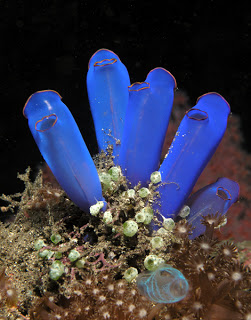
Previously, I’ve written some tidbits here involving the mechanisms of movement in organisms (see Bug Nuisances, The Mauthner Cell, and Wrasse Research) and I want to continue that trend with some peculiar creatures dwelling in the ocean deep: Ascidians of the subphylum Tunicata, also known as “sea squirts.”
On the surface, a sea squirt is quite unremarkable. Comprised primarily of cellulose, the invertebrate spends its larval years swimming freely in pelagic zones of the ocean until eventually finding a comfortable rock on which to cement itself for the remainder of its life cycle. Because the larva is not capable of feeding in the open ocean, this attachment to the seafloor allows the larval squirt to digest its own brain, thus satiating its embryonic hunger, and initiating a metamorphosis into the stationary, water-filtering, colonial bore of adult squirt life. The sessile squirt can now spend its nights “budding off new zooids” 😉 and expand its domain to more efficiently garner nutrients and diffuse waste in an everlasting game of eat, bud off, don’t die. And yet, there is still more to the sea squirt than its odd instinct for autophagia and sedentary life, particularly during its early years.
There are two components of the sea squirt that make it an interesting specimen for close study. First, the sea squirt is a chordate, which is important because humans are chordates. To be a member of Chordata, one must maintain a rod of cartilage, i.e. a notochord, that provides a variety of signaling to the rest of the body during early development. The notochord exists as a precursor to the vertebrate central nervous system, and the sea squirt, despite ultimately becoming an invertebrate, uses its notochord to receive crucial sensory feedback from its environment. In many ways, the free-swimming sea squirt resembles a tadpole in motion and in appearance, as the oscillations of their tails provide forward motion. This rudimentary notochord’s perceptual capabilities are crucial for ensuring the sea squirt’s successful navigation of the ocean deep, and despite the eventual digestion of its more central sensory components, the larval squirt certainly experiences a vertebrate existence before its adult life. Secondly, the cerebral ganglion (or cell bodies) of the larval sea squirt closely resembles those of the vertebrate brain. The cerebral ganglion accommodates a neuronal array specified for movement allowing the organism to move successfully to its target-rock until the brain is no longer needed. Comparatively, with early stages of human development, the notochord eventually differentiates into a neural tube, containing a plethora of functionally specialized cells for signaling between the brain and body’s sensory nerve afferents. While the sea squirt only maintains its notochord for simple movements and eventual sustenance, the physiologically-identical human notochord only differs in that it emerged in time with an immense array of sensory variety needed to navigate complex environments.
One particular scholar, Rodolfo Llinas in his book “I to the World”, has extrapolated these facts into a unique philosophy about the “self.” Because the sea squirt has many important neural similarities to humans, Llinas posits—somewhat controversially—that the squirt is perceiving, reacting and acting upon its environment, despite the apparently basic quality of its movements and reactions to stimuli. More specifically, the cerebral ganglion of this eventually brainless organism is not only exceptionally complex on a neuronal level, but also suggests that “predictive movement”—a realm of cognition usually reserved for animals with highly developed nervous systems—is both present and required for even the simplest of organisms. In essence, predictive movement requires an anticipation of any resulting disturbance in the environment, and this anticipation initiates a bodily counter-response for stability and posture. Together, a movement from the body must occur instantly and in synchrony with refined anticipation. To Llinas, “this temporally coherent event that binds…the fractured components of external and internal reality into a single construct is what we call the ‘self’”. A sea squirt perceives, predicts and reacts to its environment just as humans must to survive. While it is entirely debatable that the sea squirt has an organized “selfhood” guiding it through the ocean towards stationary life, it brings into question the nature of the human consciousness. If the human “self” is merely composed of simple interior responses to our surroundings, then perhaps for brief, fleeting moments in time the humble sea squirt “consciousness” of its surroundings is not too different from our own.